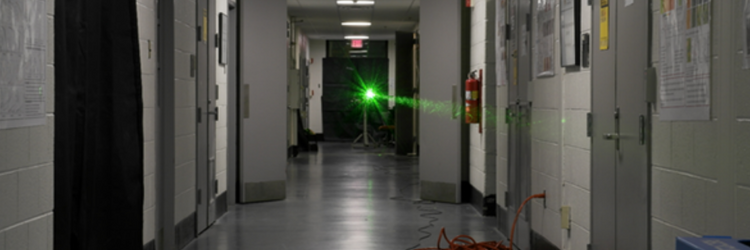Where’s Guinness when you need him? It happened at UMD’s Energy Research Facility—Physics Professor Howard Milchberg and his team transformed a hallway into a laboratory. In anticipation of the experiment, they covered all shiny surfaces to avoid potentially blinding reflections and blocked off connecting hallways with signs, caution tape, and laser-absorbing black curtains.
The team set out to temporarily transfigure thin air into a fiber optic cable—or an air waveguide—that would guide light for tens of meters. With an air waveguide, there is no need to unspool solid cable or be concerned with gravity as a cable forms unsupported in the air. Described In a paper accepted for publication in the journal Physical Review X the team set a record by guiding light in 45-meter-long air waveguides.
The experiment took place at night to avoid inconveniencing (or zapping) anyone. According to Andrew Goffin, a lead author of the resulting journal article, “There’s a lot of work that goes into shooting lasers outside the lab that you don’t have to deal with when you’re in the lab—like putting up curtains for eye safety. It was definitely tiring.”
The team used 64 microphones to measure the length and strength of the waveguide along its length (more energy going into making the waveguide translates to a louder pop).
They found that the waveguide lasted for just hundredths of a second before dissipating back into thin air, a long time for the laser bursts the researchers were sending through it. Light can traverse more than 3,000 km in that time.
The team is planning experiments to further improve the length and efficiency of their air waveguides and to guide different colors of light. They will also investigate if a faster filament pulse repetition rate can produce a waveguide to channel a continuous high-power beam.

